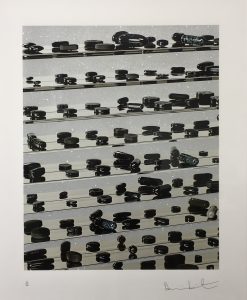
|
Damien Hirst |
About the work:
“Pills are a brilliant little form, better than any minimalist art, they’re all designed to make you buy them… they come out of flowers, plants, things from the ground, and they make you feel good.” Damien Hirst
We live in a chemical world, where everything from pain to pleasure to survival itself can be shaped by legal and illegal drugs. Many people live on a daily cocktail of prescribed pharmaceuticals, and many others take unprescribed ones. Life seems to be muffled by medicine.
Damien Hirst, the “enfant terrible” of the Young British Artist movement has often made work around the seductive allure of pharmaceuticals. His cylindrical pills and medicine cabinets have become as synonymous with the artist as the formaldehyde shark. Even his instantly recognizable Spot paintings make strong reference to medications and their effects. Hirst, who has admitted to a ten year struggle with drug and alcohol abuse in the 90’s has a deep fascination with death and mortality, themes that are front and center in most of his works.
In his series of medicine cabinets and pills, Hirst taps into both the apprehension and awe that we experience when we come into contact with alluring products that have the power to soothe away our misery, pain and reality.
This week’s Work of the Week! WOW! is Black Brilliant Utopia, by Damien Hirst. The work references the ability of pills and medication to mesmerize yet instill fear in us. Through the brilliant, sparkling of the diamond dust, the artwork plays on the aspect of temptation. Our society is drawn, almost hypnotized by medication. The layout of the pills on the shelves conveys a sense of antiseptic orderliness with an unmistakeable pharmaceutical aesthetic. This calculated precision is reassuring, however the dark hues of the pills transmit an unnerving sentiment, which brings to mind the more dire aspects of a medicated society.
Hirst’s medicine cabinets project a certain Pop Art aesthetic. The object is familiar to consumers, and connects with the artist’s philosophical preoccupations of birth and death, and more importantly, a deep belief that art heals.
